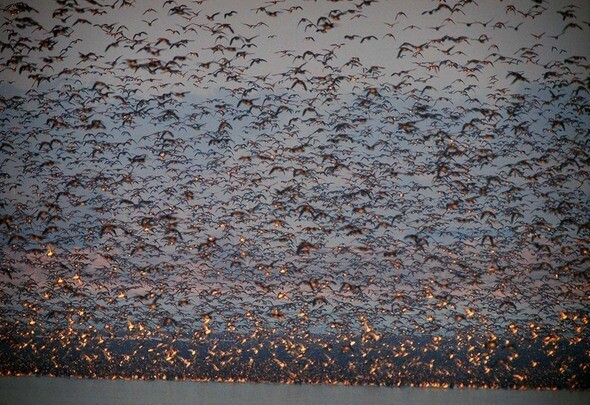hankyoreh
Links to other country sites 다른 나라 사이트 링크
Migratory birds confirmed to be source of bird flu outbreak

By Noh Hyun-woong, staff reporter
The flock of dead Baikal teal found at Dongrim Reservoir in Seongnae Township, Gochang County, North Jeolla Province was infected with avian influenza, or bird flu, authorities confirmed on Jan. 20.
“Our tests found that the dead wild migratory birds that we collected in Gochang County on Jan. 17 were infected with avian influenza. The strain was H5N8, same as the ducks that we had tested previously,” said Kwon Jae-han, director-general of the livestock policy bureau in the Ministry of Agriculture, Food, and Rural Affairs, in the press briefing on Monday. Dongrim Reservoir is a little more than 5km in a direct line from the farm where ducks contracted highly pathogenic bird flu. Growing evidence indicates that the ducks were infected by the migratory birds.
Following the discovery that the wild ducks were infected with bird flu, authorities are working frantically deal with the outbreak. While the government has set up a defensive perimeter around North Jeolla Province to prevent the disease from spreading, more outbreaks could occur simultaneously in different areas depending on the flight paths of the migratory birds. Fortunately, because the winter is not very cold this year, a fair number of Baikal teal are not moving on to South Jeolla and South Gyeongsang Provinces but instead are reportedly wintering around North Jeolla Province.
The Ministry and other disease prevention authorities are planning to identify the Baikal teal flight paths along which it is most likely that an outbreak could occur. The Ministry will then take preventive measures along those paths. The most likely areas for these efforts are Dongrim Reservoir in Gochang County and the neighboring Geumgang Lake and Yeongam Lake, all of which are vulnerable to an outbreak.
At present, around 100,000 migratory birds - including Baikal teal, whooper swan, and swan - are staying at Dongrim Reservoir. The disease prevention authorities will also step up their activities in 37 other major migratory bird preserves around the country.
On Jan. 20, the government held a meeting of the emergency livestock disease prevention committee. As expected, the committee lifted the ban on transportation, which was scheduled to last until midnight that day. While cases of avian flu had been found in wild migratory birds, the authorities deferred to the opinion of experts, who argued that the key to fighting the bird flu is sterilizing individual farms and preventing transportation between farms, authorities explained. On Monday, a total of 155,000 ducks and chickens were culled in Gochang and Buan Counties in North Jeolla Province.
Please direct questions or comments to [english@hani.co.kr]

Editorial・opinion
![[Guest essay] The real reason Korea’s new right wants to dub Rhee a founding father [Guest essay] The real reason Korea’s new right wants to dub Rhee a founding father](https://flexible.img.hani.co.kr/flexible/normal/500/300/imgdb/original/2024/0423/8317138574257878.jpg) [Guest essay] The real reason Korea’s new right wants to dub Rhee a founding father
[Guest essay] The real reason Korea’s new right wants to dub Rhee a founding father![[Column] ‘Choson’: Is it time we start referring to N. Korea in its own terms? [Column] ‘Choson’: Is it time we start referring to N. Korea in its own terms?](https://flexible.img.hani.co.kr/flexible/normal/500/300/imgdb/original/2024/0423/3617138579390322.jpg) [Column] ‘Choson’: Is it time we start referring to N. Korea in its own terms?
[Column] ‘Choson’: Is it time we start referring to N. Korea in its own terms?- [Editorial] Japan’s rewriting of history with Korea has gone too far
- [Column] The president’s questionable capacity for dialogue
- [Column] Are chaebol firms just pizza pies for families to divvy up as they please?
- [Column] Has Korea, too, crossed the Rubicon on China?
- [Correspondent’s column] In Japan’s alliance with US, echoes of its past alliances with UK
- [Editorial] Does Yoon think the Korean public is wrong?
- [Editorial] As it bolsters its alliance with US, Japan must be accountable for past
- [Guest essay] Amending the Constitution is Yoon’s key to leaving office in public’s good graces
Most viewed articles
- 1[Guest essay] The real reason Korea’s new right wants to dub Rhee a founding father
- 2Terry Anderson, AP reporter who informed world of massacre in Gwangju, dies at 76
- 3[Column] ‘Choson’: Is it time we start referring to N. Korea in its own terms?
- 4Why Korea shouldn’t welcome Japan’s newly beefed up defense cooperation with US
- 5Opposition calls Yoon’s chief of staff appointment a ‘slap in the face’
- 6[Column] The clock is ticking for Korea’s first lady
- 7Senior doctors cut hours, prepare to resign as government refuses to scrap medical reform plan
- 8New AI-based translation tools make their way into everyday life in Korea
- 9[Editorial] Japan’s rewriting of history with Korea has gone too far
- 10[Column] Are chaebol firms just pizza pies for families to divvy up as they please?